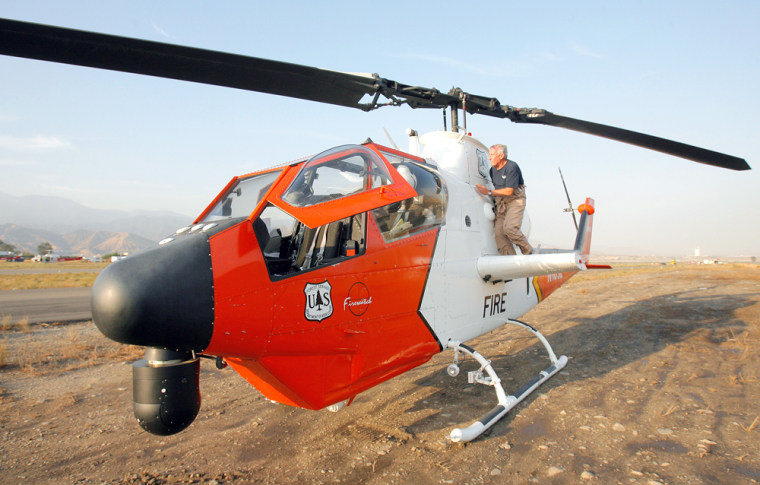Firefighters were finally able to contain a nearly 100-square-mile blaze in the desert and rugged San Bernardino National Forest, but with rain in the forecast there was a new fear: mudslides.
The National Weather Service issued a flood watch through the week in the Mojave Desert and portions of the San Bernardino National Forest, where nearly two weeks of fire left bare earth and ashes that could turn into mudslides with enough rain.
Forecasters said there was a 40 percent chance of thunderstorms Wednesday.
“The big thing is the weather,” said Rich Phelps of the U.S. Forest Service.
Cooler temperatures helped firefighters contain the blaze Tuesday night. That and a second fire have charred a combined 131 square miles.
Temperatures were some 20 degrees cooler than the triple-digit highs of last week.
Ignited by lightning July 9, the first blaze destroyed 58 houses and mobile homes, dozens of outbuildings and scores of vehicles. It was linked to 17 injuries and one death.
The second fire, about 24,210 acres and 38 square miles, merged with the other last week. It was burning in low-elevation brush and on rocky ridges dotted with pines killed by drought and a bark beetle infestation. It was 57 percent contained Tuesday.
The northwestern edge of the fires were within a few miles of mountain hamlets but “we don’t feel there’s any real threat,” Phelps said. “We’re not letting the fire grow. We’re containing it.”
Other fires in the West
Elsewhere, rain during the night helped slow a fire near Wellington, Nev., close to the California line. The fire had covered nearly 10 square miles but was 30 percent contained early Wednesday and crews hope to have it fully surrounded Friday, officials said.
The blaze had forced the evacuation of campers and a ranch.
Strong wind in central Montana pushed range fires past containment lines. One fire 25 miles north of Jordan was estimated at 31,000 acres — 48 square miles — before wind gusts of up to 50 mph hit that area, said Dena Lang, a spokeswoman for the Bureau of Land Management.
Eight major fires in southern and eastern Montana had blackened an estimated 345,000 acres — 540 square miles — as of Tuesday. Firefighters were near containment of some of the fires.
A wildfire on the Standing Rock Indian Reservation south of Bismarck, N.D., came within about 2,000 feet of a rancher’s home, but firefighters saved the home and got the blaze “pretty well contained” early Wednesday, Sioux County Sheriff Frank Landeis said. The blaze had blackened about 15 square miles, he said.
A team of highly skilled experts was headed to the Boundary Waters Canoe Area wilderness in northern Minnesota to take over the fight against a wildfire that had covered nearly 31 square miles, much of it covered by dead trees blown down by a storm in 1999.
“The complexity of this fire has reached that state,” Joe Fields, an information officer, said of the Minnesota fire. “They are the best in the business.”
The Boundary Water fire was at least a couple of miles away from people and property, officials said. Crews worked to keep the blaze away from the Gunflint Trail, a main entry point to the popular canoeing and camping region.
In the windy West, another fire exploded to 5,000 acres, nearly 8 square miles, in the Cibola National Wildlife Refuge on the Arizona and California sides of the Colorado River, officials said Wednesday. The fire threatened a few homes in California and briefly cut power to an estimated 500 to 600 residents of Cibola, Ariz., said Robin Hansen of the Arizona State Land Department.
Aircraft were called in Wednesday to help fight a fast-growing wildfire that had charred just over 1 square mile in southwestern Colorado’s Ute Mountain Tribal Park, site of ancient rock art and cliff dwellings. There were no immediate threats to archaeological sites or buildings at the park.
